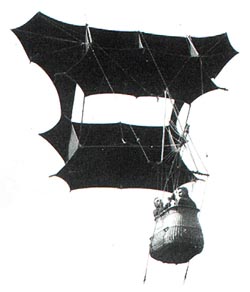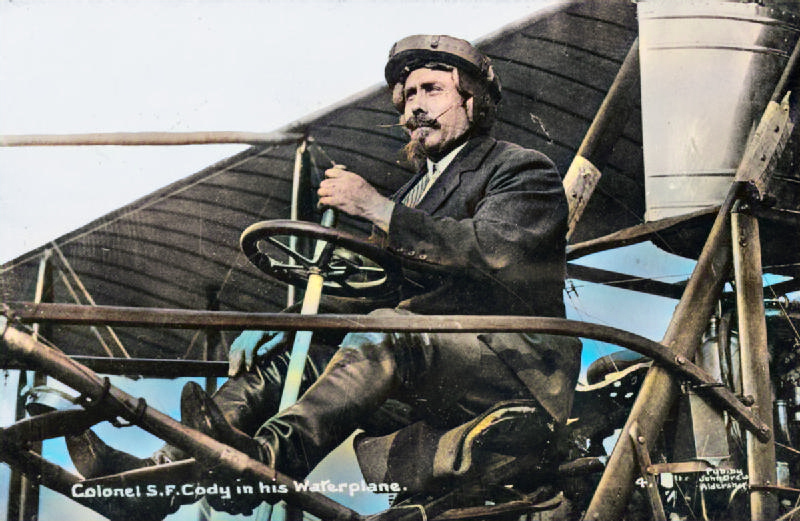
Samuel Franklin Cody (1867 – 1913)
On October 16, 1908, US Wild West showman and early pioneer of manned flight Samuel Cody succeeded with the first officially recorded powered flight in England with a length of 420 metres.
Samuel Cody – A Wildwest Showman
Samuel Cody was born Samuel Franklin Cowdery in 1867 in Davenport, Iowa, USA and attended school until he was probably 12. Not much is known about the early life of Cody, but he later told that he lived the life of a cowboy, riding and training horses, shooting and using the lasso. However, he began his career as a gold prospector, cowboy and horse trainer. At the age of 21, Cody began touring the US with Forepaugh’s Circus, which had a large Wild West show component. Some of Cody’s stage shows became quite popular including his stage show ‘The Klondyke Nugget‘. Cody had to earn money at a young age because his father was in prison and could not support the family. As a result, he apparently never attended school and was therefore illiterate. In 1880, at the age of 19, he married the Wild West Show actress Maud Marie Lee in Pennsylvania, with whom he appeared on the Forepaugh Wild West Show. At this time he took the family name Cody, after his idol Buffalo Bill.
The Cody Kite
To this day, it is unclear why Cody became fascinated by kites and many story have been told on that matter. It is widely assumed that his interest evolved during his friendship with Auguste Gaudron, a balloonist Cody met while performing at Alexandra Palace. Cody began to develop Lawrence Hargrave‘s double cell boy kite in order to increase its lifting power.[3] Hargrave was an engineer, explorer, astronomer, inventor and aeronautical pioneer. Samuel Cody also developed a sophisticated system of flying multiple kites up a single line, which was capable of ascending to many thousands of feet or of carrying several men in a gondola. He patented his design in 1901 and it became known as the Cody kite.
Fellow of the Royal Meteorological Society
Samuel Cody also saw a chance for kites use for meteorological and military observation. Even though balloons were used widely, they could only be operated in light winds while kites can only be operated in stronger winds. His kites were soon adopted for meteorology, and he was made a Fellow of the Royal Meteorological Society. In 1907 he brought a meteorological measuring instrument to a record height of 4268 meters with a kite in Cobham Common.

Man-lifter War Kite designed by Samuel Franklin Cody
Britain’s First Aeroplane
In 1905, Cody developed a completely different design looking more or less like a tailless biplane. The machine was launched on a tether like a kite and the tether was then released to allow gliding flight. It was notable in being the first known aircraft to use ailerons effectively to control roll. In 1906, Samuel Cody managed to finally interest the British Army in his kites and was appointed Chief Instructor of Kiting for the Balloon School in Aldershot and soon after joined the new Army Balloon Factory down the road at Farnborough. The factory eventually became the Royal Aircraft Establishment. In 1908, the War Office officially adopted Cody’s kites for the Balloon Companies he had been training. This group would in due course evolve into the Air Battalion of the Royal Engineers, No. 1 Company of which later became No. 1 Squadron, Royal Flying Corps and eventually No. 1 Squadron Royal Air Force. In 1907, Cody designed an unmanned kite similar to his standard designs but with much bigger wings and a tailplane with twin fins in place of the rear cell, this was fitted with a 15 hp Buchet engine. However, he was not allowed to fly the kite free in the open and mostly flew it indoors. All that remained to him was to bring the manned-free-flying glider together with the power-kite’s engine to create Britain’s first aeroplane.

A close up of Cody wearing his flying helmet in the cockpit of the Cody aircraft mark V (1912)
First Heavier than Air Flight in Britain
The Army decided to back the development of Samuel Cody’s powered aeroplane. After just one year of construction, Cody tested the machine of the British Army Aeroplane No 1 and on October 16, 1908, he reached 420 metres. His flight of 16 October is recognized as the first official flight of a piloted heavier than air machine in Great Britain. In the following year, the Army stoped its support and the aircraft was given to Cody who succeeded flying for over a mile, establishing the first official British distance and endurance records. He even started carrying passengers for the first time on 14 August 1909 and became the first man to fly from Liverpool in an unsuccessful attempt to fly non-stop between Liverpool and Manchester. On September 8, 1909, Cody ascended to a 63-minute flight. In the process he improved Louis Blériot‘s official world record for cross-country flights from 25 to 40 miles.[4] Samuel Cody received the Royal Aero Club certificate number 9 using a newly built aircraft and later in the year won the Michelin Cup for the longest flight made in England during 1910 with a flight of 4 hours 47 minutes on 31 December.
The Accident
On August 7, 1913, at the age of 52, Cody died with his passenger, the cricketer William Evans during the flight of his last invention, a seaplane, over Laffan`s Plain (Aldershot, Southern England) when it broke apart in mid-air. Cody was buried in Aldershot, about 50 km southwest of central London.
TRANSPORT: Aviation: Colonel Samuel Franklin Cody killed in plane crash (1913) [9]
References and Further Reading:
- [1] Samuel Franklin Cody Website
- [2] Samuel Cody at Early Aviators
- [3] Lawrence Hargrave and the Box Kite, SciHI Blog
- [4] Louis Blèriot’s famous Flight across the English Channel, SciHi Blog
- [5] Ralph Cooper: Samuel Franklin Cody 1867-1913.
- [6] “The real Samuel Cody”. BBC: Hampshire and Isle of Wight. 13 November 2014
- [7] Samuel Franklin Cody Papers at the Autry National Center
- [8] Samuel Franklin Cody at Wikidata
- [9] TRANSPORT: Aviation: Colonel Samuel Franklin Cody killed in plane crash (1913), GAUMONT GRAPHIC NEWSREEL (REUTERS), British Pathé
- [10] Timeline of Kite Fliers, via Wikidata and DBpedia





